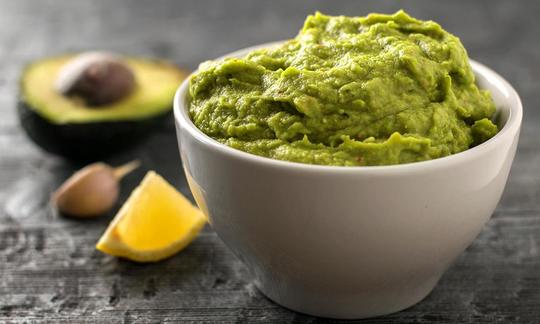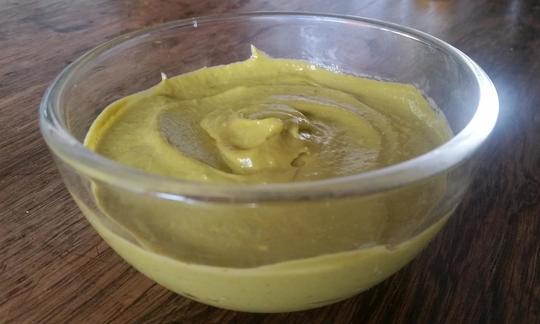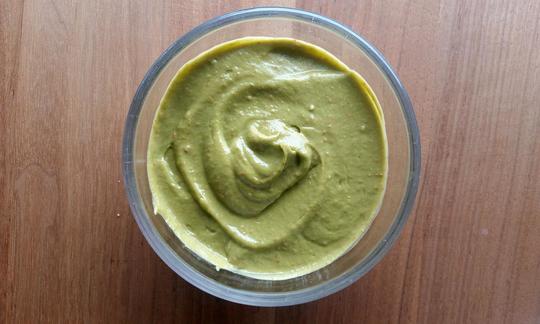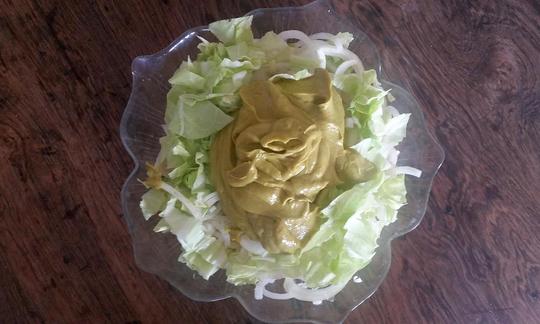Vegan raw avocado garlic cream with umami flavor
raw-vegan
Ingredients (for servings, )
| 4 | Tomatoes, dried (raw?, organic?) (0.70 oz) |
| 2 | Avocados, raw (organic?) (14 oz) |
| ½ | Lemons, raw (limes, organic?) (1.0 oz) |
| 2 cloves | Garlic (organic?) (0.21 oz) |
Equipment
- hand-held blender / immersion blender
- garlic press
- citrus juicer (lemon squeezer)
Type of preparation
- food preparation without heating
- soak
- squeeze
- purée
- remove the skin
Preparation
soaking
Soak the dried tomatoes in lukewarm water for about 40 minutes. Then drain the water and collect it (you will need some of it later).The longer the dried tomatoes are soaked, the creamier the consistency of the finished avocado garlic cream.
For the avocado garlic cream
Remove the skin and pit from the avocados and chop roughly. Squeeze the lemon and add the juice to the avocado to prevent it from turning brown. Peel the garlic.Press the garlic cloves with a garlic press.
Cut the soaked dried tomatoes into small pieces to make it easier for the blender.If you don't have a garlic press, you can also finely chop the garlic with a knife.
Put the prepared ingredients into the blender. Add some of the soaking water from the dried tomatoes.
We recommend starting with less soaking water and adding more as needed.
Arranging and Serving
Serve the avocado garlic cream as a dip or as a salad dressing.If using as a salad dressing, add a little more liquid than for the dip.
|
Nutritional Information per person
Convert per 100g
|
2000 kcal | |
|---|---|---|
| Energy | 356 kcal | 17.8% |
| Fat/Lipids | 30 g | 42.6% |
| Saturated Fats | 4.3 g | 21.6% |
| Carbohydrates (inc.dietary fiber) | 25 g | 9.3% |
| Sugars | 5.5 g | 6.1% |
| Fiber | 15 g | 60.7% |
| Protein/Albumin | 5.8 g | 11.6% |
| Cooking Salt (Na:25.6 mg) | 65 mg | 2.7% |
| Essential micronutrients with the highest proportions | per person | 2000 kcal | |
|---|---|---|---|
| Vit | Vitamin B9, B11 (Folate, as the active form of folic acid) | 171 µg | 86.0% |
| Elem | Potassium, K | 1'350 mg | 67.0% |
| Vit | Vitamin K | 47 µg | 62.0% |
| Min | Copper, Cu | 0.54 mg | 54.0% |
| Vit | Vitamin B5 (Pantothenic acid) | 3.0 mg | 51.0% |
| Vit | Vitamin B6 (pyridoxine) | 0.60 mg | 43.0% |
| Vit | Vitamin C (ascorbic acid) | 33 mg | 41.0% |
| Vit | Vitamin E, as a-TEs | 4.2 mg | 35.0% |
| Fat | Linoleic acid; LA; 18:2 omega-6 | 3.5 g | 35.0% |
| Vit | Vitamin B3 (Niacin) | 4.4 mg | 28.0% |
Detailed Nutritional Information per Person for this Recipe
The majority of the nutritional information comes from the USDA (US Department of Agriculture). This means that the information for natural products is often incomplete or only given within broader categories, whereas in most cases products made from these have more complete information displayed.
If we take flaxseed, for example, the important essential amino acid ALA (omega-3) is only included in an overarching category whereas for flaxseed oil ALA is listed specifically. In time, we will be able to change this, but it will require a lot of work. An “i” appears behind ingredients that have been adjusted and an explanation appears when you hover over this symbol.
For Erb Muesli, the original calculations resulted in 48 % of the daily requirement of ALA — but with the correction, we see that the muesli actually covers >100 % of the necessary recommendation for the omega-3 fatty acid ALA. Our goal is to eventually be able to compare the nutritional value of our recipes with those that are used in conventional western lifestyles.
| Essential fatty acids | per person | 2000 kcal |
|---|---|---|
| Linoleic acid; LA; 18:2 omega-6 | 3.5 g | 35.0% |
| Alpha-Linolenic acid; ALA; 18:3 omega-3 | 0.23 g | 11.0% |
| Essential amino acids | per person | 2000 kcal |
|---|---|---|
| Tryptophan (Trp, W) | 0.06 g | 25.0% |
| Threonine (Thr, T, irreversibly transaminated) | 0.19 g | 20.0% |
| Isoleucine (Ile, I) | 0.21 g | 17.0% |
| Lysine (Lys, K, irreversibly transaminated) | 0.32 g | 17.0% |
| Valin (Val, V) | 0.26 g | 16.0% |
| Phenylalanine (Phe, F) | 0.24 g | 15.0% |
| Leucine (Leu, L) | 0.35 g | 14.0% |
| Methionine (Met, M) | 0.09 g | 10.0% |
| Vitamins | per person | 2000 kcal |
|---|---|---|
| Vitamin B9, B11 (Folate, as the active form of folic acid) | 171 µg | 86.0% |
| Vitamin K | 47 µg | 62.0% |
| Vitamin B5 (Pantothenic acid) | 3.0 mg | 51.0% |
| Vitamin B6 (pyridoxine) | 0.60 mg | 43.0% |
| Vitamin C (ascorbic acid) | 33 mg | 41.0% |
| Vitamin E, as a-TEs | 4.2 mg | 35.0% |
| Vitamin B3 (Niacin) | 4.4 mg | 28.0% |
| Vitamin B2 (Riboflavin) | 0.32 mg | 23.0% |
| Vitamin B1 (Thiamine) | 0.20 mg | 18.0% |
| Vitamin B7 (Biotin, ex vitamin H) | 1.6 µg | 3.0% |
| Vitamin A, as RAE | 19 µg | 2.0% |
| Essential macroelements (macronutrients) | per person | 2000 kcal |
|---|---|---|
| Potassium, K | 1'350 mg | 67.0% |
| Magnesium, Mg | 80 mg | 21.0% |
| Phosphorus, P | 147 mg | 21.0% |
| Calcium, Ca | 44 mg | 6.0% |
| Sodium, Na | 26 mg | 3.0% |
| Essential trace elements (micronutrients) | per person | 2000 kcal |
|---|---|---|
| Copper, Cu | 0.54 mg | 54.0% |
| Manganese, Mn | 0.52 mg | 26.0% |
| Iron, Fe | 2.2 mg | 15.0% |
| Zinc, Zn | 1.5 mg | 15.0% |
| Selenium, Se | 1.8 µg | 3.0% |
| Fluorine, F | 16 µg | < 0.1% |
| Iod, I (Jod, J) | 0.72 µg | < 0.1% |
The vegan raw avocado garlic cream has an umami taste and is not only a culinary interesting variation of the classic guacamole.
Nutrient profile: According to GDA guidelines, one portion of this recipe covers more than the average daily requirement of vitamin D and 86% of the daily requirement of folic acid. However, due to the avocado, this dish has a very poor ratio of omega-6 to omega-3 fatty acids of 15:1, which is well below the recommended maximum ratio of 5:1. This should be compensated for by other foods such as walnuts, macadamia nuts or, best of all, linseed. See Erb-Müesli.
Avocado: The avocado has the highest fat content of all known fruits and vegetables and is rich in unsaturated fatty acids and potassium. The high fat content and the resulting consistency of the flesh has earned the avocado the nickname "butter fruit".
Dried tomatoes: When dried, the tomatoes lose their moisture and thus deprive the microorganisms of their livelihood, which means that the tomatoes last longer. The concentration of aromatic substances also increases, which is why dried tomatoes have a very intense taste.
Umami: Umami, Japanese for delicious, is the fifth taste alongside sweet, salty, sour and bitter. Umami taste is mainly caused by glutamate, the salt of glutamic acid. This occurs naturally in foods such as meat, mushrooms and tomatoes.
Lemon juice: In addition to flavoring, lemon juice can also be used as a temporary preservative for certain foods (avocado, apples, bananas, etc.). This is because the citric acid contained in the fruit reduces the pH and complexes metal ions, which has a negative effect on the oxidation potential of atmospheric oxygen and the activity of the enzymes involved in the browning process. Citric acid is also approved in the EU as a food additive under the number E 330 and is also present in our metabolism (citrate cycle). Since the acids contained in lemon juice attack tooth enamel, you should avoid brushing your teeth immediately after consuming lemon juice. This is because the mechanical forces used during the brushing process can cause abrasion (rubbing away) of the affected tooth enamel.
Preventing avocados from turning brown: Cutting the avocados causes a break in the affected cell walls, which exposes the substances that escape to the oxidation process. This in turn causes the flesh to turn brown unless preventative measures are taken, such as applying antioxidants. Drizzling with lemon or lime juice can prevent this and also goes well with the dish.
Storage of avocados: Avocados are harvested when they are unripe. To ripen them, it is best to place avocados next to apples (or put them together in a paper bag) and store them at room temperature. The apple emits the gas ethylene, which promotes ripening.
You can also add finely chopped chili pepper and coriander to the avocado garlic cream for a spicier version of the cream.










